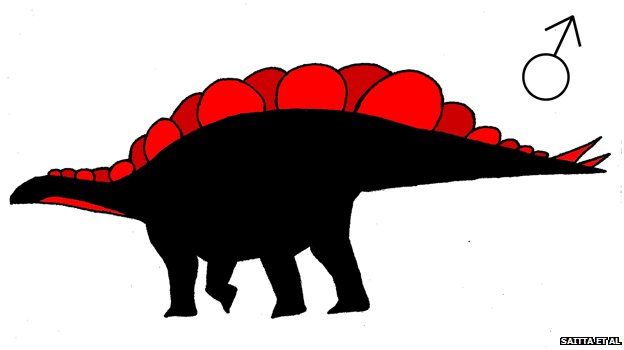Graveyard clue to stegosaur plates
- Published

Stegosaurs may have had quite different shaped plates, depending on whether they were male or female.
The bony appendages that ran down the backs of these animals made them among the most iconic of dinosaur species.
But quite what their purpose was is something of a mystery.
Now, new research, published in the journal PLoS ONE, claims that males could have sported rounder, broader plates, while females might have had narrower, taller plates.
Evan Saitta, from Bristol University, UK, examined the remains of stegosaurs preserved in a "graveyard" of these creatures in Central Montana, US.
The jumble of fossils contained at least five individuals and he compared their skeletons with those of other specimens of the same species - Stegosaurus mjosi - from previous collections.
The researcher's analysis shows that the plates fell into two distinct forms, and that this variation could not be explained, for example, by differing growth stages.
"Simply looking at them by eye, you can identify two varieties. But then you can also measure them and do a more quantitative analysis and demonstrate that, yes, there are two distinct varieties of plates, and that there don't appear to be any clear-cut intermediates," Mr Saitta told BBC News.
As a consequence, he proposes that the two forms are likely to be an example of so-called sexual dimorphism. This describes the situation where the males and females of the same species can evolve dissimilar forms.
The Bristol scientist cannot say for sure which plate shape belonged to which sex, but he makes the case that the larger, rounded ones would have been found on males.
"We know from modern animals that males typically invest more into their ornaments than do the females. In this case, the broader variety reaches sizes 45% larger in surface area than do the tall plates. And I argue that these wide plates would create a great 'billboard' for male stegosaurs if they were using them to attract a mate."
It does raise the question, of course, of why the females also then had plates. But Mr Saitta points to other modern animals where reduced forms also appear in the female of a species to serve as a protection against predators. This is seen in many horned species, for instance.
"So in stegosaurs we have sexual selection causing males to grow big, showy plates, but because there are predators, you also have a selection for females to grow spiky plates in order to deter attack," he explained.
The research pitches in to the debate over the function of the appendages.
London's Natural History Museum is currently engaged in a big stegosaur study based on what is regarded as the most complete fossil stegosaur specimen in the world.
The NHM intends to test the various plate theories, including assessing whether they were strong enough to act as a defence system. One alternative idea is that the plates behaved like radiators, helping to cool the animals when they got too warm.
The museum's Paul Barrett said he thought the new paper was an interesting discussion point but that he was not convinced the data quite supported the arguments.
"They're not quite watertight for me - not yet," he told BBC News.
"I'd like to see a lot more information on the graveyard site itself, the different sizes of the specimens, how they were arranged in the ground, more detail on the geology, and on the analyses that were done. But it is interesting because it would add to the debate on what the plates were for. Sexual dimorphism is something we see a lot in modern animals, although it's not particularly prevalent (in terms of skeletal structure) in living reptiles or in living birds.
"Most of the dimorphism we see in living reptiles and birds comes down to things like colour, scale patters, feather patterns and actual body size. These are the most obvious ways that males and females differ from each other, apart from the sex organs."
Stegosaurs were large, herbivorous dinosaurs that lived roughly 150 million years ago. As well as the bony plates, which were positioned in two staggered rows along the back, they also had bony spikes on the end of their tail.
Jonathan.Amos-INTERNET@bbc.co.uk and follow me on Twitter: @BBCAmos
- Published4 March 2015
- Published29 January 2015
- Published3 December 2014